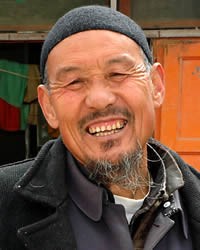Dongxiang in China

Photo Source:
Peter Morgan - Wikimedia
Creative Commons
|
Send Joshua Project a map of this people group.
|
| People Name: | Dongxiang |
| Country: | China |
| 10/40 Window: | Yes |
| Population: | 775,000 |
| World Population: | 775,000 |
| Primary Language: | Dongxiang |
| Primary Religion: | Islam |
| Christian Adherents: | 0.00 % |
| Evangelicals: | 0.00 % |
| Scripture: | New Testament |
| Ministry Resources: | Yes |
| Jesus Film: | Yes |
| Audio Recordings: | Yes |
| People Cluster: | Chinese Muslim |
| Affinity Bloc: | East Asian Peoples |
| Progress Level: |
|
Introduction / History
In the thirteenth century China was subdued by the Mongols. In a bid to control the land he had taken over, Genghis Khan moved some of his garrisons into China. These soldiers intermarried with local women and gradually developed into their own distinct ethnic group called the Dongxiang. Some placenames seem to support this theory. For example, Zhayingtan (Encampment Beach), is said to be the site of an old Dongxiang garrison.
The Dongxiang are one of China's official minority groups. They were called Mongolian Huihui prior to 1949, when their name was changed to the Dongxiang (East District) people. They call themselves by the Islamic term Santa. Other Muslims in China do not consider the Dongxiang to be a part of the Islamic faith because of their involvement in drug and prostitution rackets.
The Dongxiang speak a Mongolian language. "Quite a few words in the Dongxiang lexicon resemble words of the same meaning in Modern Mongolian, and some are even identical to words presently used in Inner Mongolia. Many other words are close to the Middle Mongolian spoken in the thirteenth and fourteenth centuries." Only 12% of the Dongxiang are literate in Chinese.
What Are Their Lives Like?
The Dongxiang are primarily employed as farmers. Their main crops are potatoes, barley, millet, wheat, and corn. They are also renowned across China for producing traditional rugs.
What Are Their Beliefs?
Not long after the Dongxiang first arrived in China, they were converted to Islam. By 1949, when the communists took over China, there was one mosque for every 30 Dongxiang homes and one paid Muslim worker for every nine families. The majority of Dongxiang belong to the Old Sect, which emphasizes worshiping at the tombs of Muslim saints. "The remainder belong to the New Sect, a fundamentalist and reformist group." There were numerous brutal wars between the two Dongxiang sects in the last century.
In the 1940s some missionaries briefly visited the Dongxiang area but were unsuccessful in converting anyone to Christ. In 1993 a Hong Kong based organization conducted mass literature evangelism in the main Dongxiang town. The nearest church to the Dongxiang is a Han Chinese fellowship in Linxia.
What Are Their Needs?
Without the guidance of Christ, these people will be spiritually lost in this life and the life to come. They need someone to go to them as Christ-bearers.
Prayer Points
Pray for the Lord to intervene in their families, calling people to his side.
Pray for loving, anointed workers.
Pray for their hearts to be drawn to the Lord of lords.
Pray for a church planting movement to thrive in their communities.